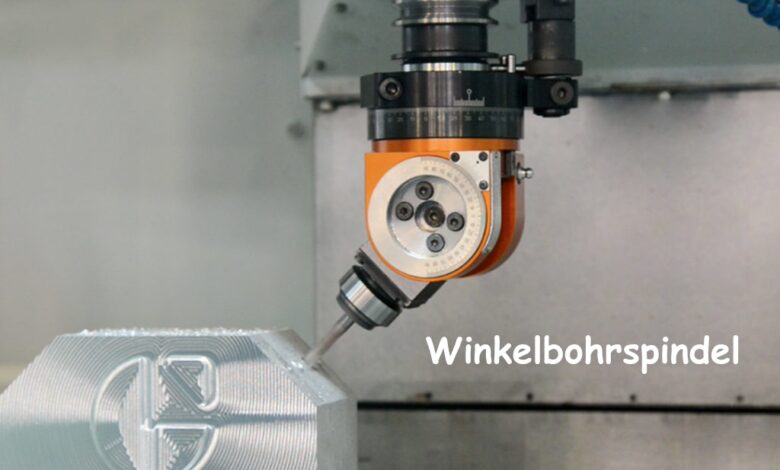Winkelbohrspindel: The Precision Powerhouse Behind Modern Machining

In the world of mechanical engineering and advanced manufacturing, one term that quietly powers efficiency, precision, and innovation is Winkelbohrspindel — a German term that translates roughly to angle drilling spindle. While it may sound technical or niche, the Winkelbohrspindel is actually a cornerstone component in many industries that rely on precision drilling and milling in tight or awkward spaces. Whether in aerospace, automotive, or complex tooling operations, this spindle is the unsung hero that allows engineers to do what straight tools simply can’t.
In this article, we’ll break down what a Winkelbohrspindel actually is, why it’s so essential in modern machining, the technology behind it, and how it continues to shape the future of high-precision manufacturing. Let’s dig in.
Understanding the Basics: What Is a Winkelbohrspindel?
At its core, a Winkelbohrspindel is a spindle attachment designed to allow drilling or milling at an angle — usually 90 degrees — to the main machine axis. Think of it as a high-precision extension or adaptor that transfers rotational power from the machine’s spindle to a cutting tool positioned at a specific angle. This capability opens up entirely new geometries and access points during the machining process.
For example, imagine trying to drill a hole inside a deep cavity or on a side surface that’s nearly impossible to reach directly. A standard vertical spindle simply can’t approach such a spot without repositioning the workpiece or using complicated setups. That’s where the Winkelbohrspindel steps in — it lets you perform the operation smoothly and accurately, saving both time and material.
Most Winkelbohrspindeln are compact, rigid, and built from high-grade materials like hardened steel and aluminum alloys. They feature precision bearings that ensure smooth rotation even at high speeds, and their angular gear systems transfer torque efficiently while minimizing vibration and backlash. This combination makes them indispensable for any scenario where direct-axis drilling just isn’t enough.
Another key feature is modularity. Many modern Winkelbohrspindeln are designed to be interchangeable, meaning they can be easily mounted on CNC machines, machining centers, or even manual setups with the right adaptors. This adaptability makes them both practical and cost-effective, especially for shops that handle a variety of parts and materials.
Why the Winkelbohrspindel Matters in Modern Manufacturing

In today’s fast-paced production environments, precision and flexibility aren’t just desirable — they’re non-negotiable. Every manufacturer is racing to reduce cycle times, improve part quality, and maintain consistent results across batches. The Winkelbohrspindel plays a critical role in achieving these goals.
First and foremost, it reduces the need for part repositioning. Traditionally, if a machinist wanted to drill an angled or lateral hole, the workpiece might have to be reclamped multiple times — a process that introduces errors, consumes valuable time, and risks misalignment. With a Winkelbohrspindel, these issues practically disappear. The tool does the angling, not the operator, leading to faster and more precise outcomes.
Secondly, it enhances accessibility. Complex components, especially those in aerospace or automotive applications, often feature intricate internal geometries or multi-axis holes that cannot be approached by standard drills. The Winkelbohrspindel makes it possible to reach those hard-to-access areas while maintaining perfect alignment and consistent cutting parameters.
And perhaps most importantly, it boosts machine versatility. A CNC machine equipped with various spindle attachments, including angular heads, can perform a far wider range of tasks without the need for additional specialized equipment. That means manufacturers can handle more complex projects on the same platform — a clear win for both productivity and profitability.
In essence, the Winkelbohrspindel is a small investment that delivers big results in terms of efficiency, accuracy, and cost control. It’s one of those components that, once introduced into a production line, quickly becomes indispensable.
Technical Insights: How the Winkelbohrspindel Works
Let’s get a bit more technical for a moment. The Winkelbohrspindel operates through a mechanical gear transmission system that redirects the rotational motion of the main spindle. Most commonly, this redirection occurs at a 90-degree angle via bevel gears or spiral bevel gears — precision-machined components that ensure smooth torque transfer and minimal power loss.
These gear systems are enclosed within a rigid housing, often sealed to prevent dust or coolant ingress. Inside, high-precision bearings support both the input and output shafts, ensuring smooth, high-speed operation with minimal vibration. The output end typically holds the cutting tool — such as a drill bit, reamer, or end mill — through a collet or chuck system.
Many advanced Winkelbohrspindeln come with integrated coolant channels, allowing high-pressure coolant to reach the cutting zone directly. This feature dramatically extends tool life and improves chip evacuation, especially in deep-hole drilling or when working with tough materials like titanium or Inconel.
Modern versions may also incorporate torque limiters and overload protection systems, preventing damage if excessive resistance is encountered. This not only safeguards the spindle but also helps maintain consistent machining quality. Some even include sensor feedback for real-time monitoring of spindle speed, temperature, and torque, connecting seamlessly with smart CNC systems.
All these details may sound complex, but in practice, the Winkelbohrspindel is a beautifully engineered solution to a simple problem — reaching and machining areas that would otherwise be out of reach.
Applications Across Industries
The versatility of the Winkelbohrspindel has made it a favorite across a wide range of industries. In automotive manufacturing, it’s commonly used to machine engine blocks, gear housings, and transmission components, where multiple holes at different angles are required. Its precision and repeatability ensure that each component fits perfectly within tight mechanical tolerances.
In the aerospace sector, the demand for lightweight, high-strength materials and complex geometries makes the Winkelbohrspindel invaluable. Aircraft components often require intricate internal passages or angled connections for fluid systems, all of which benefit from the precision and reach of an angular spindle attachment.
The medical device industry also relies heavily on these spindles. Many surgical tools and implant components require intricate shaping and hole placement that can’t be achieved through standard drilling methods. The Winkelbohrspindel enables manufacturers to maintain accuracy while handling delicate materials like titanium or surgical-grade stainless steel.
Even outside high-tech sectors, industries like mold and die manufacturing and general engineering make use of Winkelbohrspindeln to simplify complex setups. Whether it’s creating side holes in molds or finishing hard-to-reach surfaces, the spindle’s ability to access unconventional angles is a universal advantage.
Choosing the Right Winkelbohrspindel
Not all Winkelbohrspindeln are created equal, and choosing the right one depends heavily on your specific application. Factors like spindle speed, torque requirements, tool interface, and machine compatibility all play crucial roles.
Winkelbohrspindel For high-speed drilling in softer materials like aluminum or composites, a lightweight spindle with higher RPM capability might be ideal. On the other hand, heavy-duty machining in steel or cast iron demands a sturdier, torque-optimized spindle capable of handling greater cutting forces.
Manufacturers should also consider maintenance requirements and ease of use. Quick-change mechanisms, sealed bearings, and modular designs can significantly reduce downtime and extend the life of the spindle. Additionally, ensure compatibility with your existing machine tool — most suppliers offer detailed specifications and customization options to fit a wide range of CNC models.
Lastly, working with a reputable manufacturer that provides good technical support can make all the difference. A well-built Winkelbohrspindel can last for years, but only if it’s properly selected, installed, and maintained.
The Future of Winkelbohrspindel Technology
As manufacturing continues to evolve toward automation and digital integration, the humble Winkelbohrspindel is not being left behind. Today’s designs are increasingly lightweight, smart, and connected, thanks to advancements in materials and sensor technology.
Expect to see IoT-enabled Winkelbohrspindeln capable of communicating with CNC systems to provide real-time diagnostics and predictive maintenance alerts. This ensures minimal downtime and maximized efficiency on the shop floor. Additionally, additive manufacturing techniques are being used to create lighter, more efficient spindle housings with internal cooling and lubrication channels.
Sustainability is another growing focus. By improving efficiency and reducing waste during machining, these spindles indirectly contribute to more sustainable manufacturing practices — a small but meaningful step toward greener production environments.
In short, the Winkelbohrspindel is evolving from a simple mechanical accessory to an intelligent, integrated part of the manufacturing ecosystem. Its role is becoming even more critical as industries push for greater precision, automation, and adaptability.
Conclusion: The Unsung Hero of Precision Engineering
While it may not grab headlines like robotic arms or AI-driven CNC systems, the Winkelbohrspindel remains one of the most essential tools in modern machining. It represents the perfect blend of mechanical ingenuity and practical design — a device that turns challenging angles into accessible opportunities.
From improving accuracy and efficiency to enabling complex geometries and smarter workflows, the Winkelbohrspindel has proven time and again that precision engineering is as much about clever design as it is about raw power. For any shop aiming to expand its capabilities, investing in the right Winkelbohrspindel isn’t just a smart move — it’s a strategic one.



